Influence of Injection Timing on Performance and Exhaust Emission of CI Engine Fuelled with Butanol-Diesel Using a 1D GT-Power Model
Abstract
1. Introduction
1.1. Research Background
1.2. Research Objective
1.3. Model Description
1.4. Butanol as an Alternative Fuel
2. Results and Discussions
2.1. Numerical Validation
2.2. Combustion Analysis
3. In-Cylinder Pressure
4. Pressure Rise Rate
5. Heat Release Rate
6. Cumulative Heat Release (CHR)
7. In-Cylinder Temperature
8. Diesel Engine Emissions
8.1. Nitrogen Oxides (NOX)
8.2. CO2 Pollution
8.3. CO Emission
8.4. HC Emission
9. Diesel Engine Performance
9.1. Exhaust Gas Temperature
9.2. Brake Thermal Efficiency
9.3. Brake Specific Fuel Consumption (BSFC)
10. Conclusions
Author Contributions
Funding
Conflicts of Interest
Nomenclature
| Qcomb | Total heat released |
| dQn | Apparent heat release rate |
| mf | Mass of fuel |
| Qht | Heat lost to the cylinder walls |
| P | Cylinder Pressure |
| Tg | The gas instantaneous temperature |
| θo | Start of combustion |
| Δθb | Combustion duration |
| Tc | Critical temperature of butanol |
| x | Molar fraction of butanol |
| µL | Viscosity at liquid phase |
| µV | Viscosity at vapor phase |
| xb | Mass fraction of burned gases |
| Tw | Cylinder wall temperature |
| A | Cylinder heat transfer area |
| hg | Heat transfer coefficient |
| V | Cylinder volume |
| γ | Ratio of specific heats |
| BTE | Brake thermal efficiency |
| °CA | Degrees of crank angle |
| BMEP | Brake mean effective pressure |
| CO | Carbon monoxide |
| CO2 | Carbon dioxide |
| NOX | Nitrogen oxides |
| HC | Hydrocarbon |
| LHV | Lower heating value |
| BSFC | Brake specific fuel consumption |
| IT | Injection timing |
| ppm | Parts per million |
| EGT | Exhaust gas temperature |
| PRR | Pressure rise rate |
References
- Bayraktar, H. An Experimental Study on the Performance Parameters of an Experimental Ci Engine Fueled with Diesel–Methanol–Dodecanol Blends. Fuel 2008, 87, 158–164. [Google Scholar] [CrossRef]
- Liu, J.; Yao, A.; Yao, C. Effects of Injection Timing on Performance and Emissions of a Hd Diesel Engine with Dmcc. Fuel 2014, 134, 107–113. [Google Scholar] [CrossRef]
- Broatch, A.; Luján, J.M.; Ruiz, S.; Olmeda, P. Measurement of Hydrocarbon and Carbon Monoxide Emissions During the Starting of Automotive Di Diesel Engines. Int. J. Automot. Technol. 2008, 9, 129–140. [Google Scholar] [CrossRef]
- Heywood, J.B. Internal Combustion Engine Fundamentals; McGraw-Hill Education: New York, NY, USA, 1988. [Google Scholar]
- Stone, R. Introduction to Internal Combustion Engines; Springer: Berlin/Heidelberg, Germany, 1999. [Google Scholar]
- Angelica, H.; Golubkov, I.; Kronberg, B.; van Stam, J. Alternative Fuel for a Standard Diesel Engine. Int. J. Engine Res. 2006, 7, 51–63. [Google Scholar]
- Yilmaz, N.; Vigil, F.M. Potential Use of a Blend of Diesel, Biodiesel, Alcohols and Vegetable Oil in Compression Ignition Engines. Fuel 2014, 124, 168–172. [Google Scholar] [CrossRef]
- Sarathy, S.M.; Thomson, M.J.; Togbé, C.; Dagaut, P.; Halter, F.; Mounaim-Rousselle, C. An Experimental and Kinetic Modeling Study of N-Butanol Combustion. Combust. Flame 2009, 156, 852–864. [Google Scholar] [CrossRef]
- Doğan, O. The Influence of N-Butanol/Diesel Fuel Blends Utilization on a Small Diesel Engine Performance and Emissions. Fuel 2011, 90, 2467–2472. [Google Scholar] [CrossRef]
- Sayin, C. Engine Performance and Exhaust Gas Emissions of Methanol and Ethanol–Diesel Blends. Fuel 2010, 89, 3410–3415. [Google Scholar] [CrossRef]
- Rakopoulos, D.C.; Rakopoulos, C.D.; Papagiannakis, R.G.; Kyritsis, D.C. Combustion Heat Release Analysis of Ethanol or N-Butanol Diesel Fuel Blends in Heavy-Duty Di Diesel Engine. Fuel 2011, 90, 1855–1867. [Google Scholar] [CrossRef]
- Abu-Qudais, M.; Haddad, O.; Qudaisat, M. The Effect of Alcohol Fumigation on Diesel Engine Performance and Emissions. Energy Convers. Manag. 2000, 41, 389–399. [Google Scholar] [CrossRef]
- Ajav, E.A.; Singh, B.; Bhattacharya, T.K. Thermal Balance of a Single Cylinder Diesel Engine Operating on Alternative Fuels. Energy Convers. Manag. 2000, 41, 1533–1541. [Google Scholar] [CrossRef]
- da Silva, T.; Roberto, W.; dos Santos, R.G. Review on the Characteristics of Butanol, Its Production and Use as Fuel in Internal Combustion Engines. Renew. Sustain. Energy Rev. 2017, 69, 642–651. [Google Scholar]
- Green, E.M. Fermentative Production of Butanol—The Industrial Perspective. Curr. Opinion Biotechnol. 2011, 22, 337–343. [Google Scholar] [CrossRef] [PubMed]
- Dürre, P. Biobutanol: An Attractive Biofuel. Biotechnol. J. Healthc. Nutr. Technol. 2007, 2, 1525–1534. [Google Scholar] [CrossRef]
- Algayyim, S.J.b.M.; Wandel, A.P.; Yusaf, T.; Hamawand, I. Production and Application of Abe as a Biofuel. Renew. Sustain. Energy Rev. 2018, 82, 1195–1214. [Google Scholar] [CrossRef]
- Koonin, S.E. Getting Serious About Biofuels; American Association for the Advancement of Science: Washington, DC, USA, 2006. [Google Scholar]
- World, Research Reports. N-Butanol Market 2019 |Global Industry Analysis by Trends, Size, Share, Company Overview, Growth and Forecast by 2025; Latest Research Report; Research Reports World: Pune, India, 11 April 2019. [Google Scholar]
- Chen, Z.; Liu, J.; Han, Z.; Du, B.; Liu, Y.; Lee, C. Study on Performance and Emissions of a Passenger-Car Diesel Engine Fueled with Butanol–Diesel Blends. Energy 2013, 55, 638–646. [Google Scholar] [CrossRef]
- Rakopoulos, D.C.; Rakopoulos, C.D.; Giakoumis, E.G.; Dimaratos, A.M.; Kyritsis, D.C. Effects of Butanol–Diesel Fuel Blends on the Performance and Emissions of a High-Speed Di Diesel Engine. Energy Convers. Manag. 2010, 51, 1989–1997. [Google Scholar] [CrossRef]
- Lapuerta, M.; Hernández, J.J.; Rodríguez-Fernández, J.; Barba, J.; Ramos, A.; Fernández-Rodríguez, D. Emission Benefits from the Use of N-Butanol Blends in a Euro 6 Diesel Engine. Int. J. Engine Res. 2018, 19, 1099–1112. [Google Scholar] [CrossRef]
- Yusri, I.M.; Mamat, R.; Ali, O.M.; Aziz, A.; Akasyah, M.K.; Kamarulzaman, M.K.; Ihsan, C.K.; Mahmadul, H.M.; Rosdi, S.M. Combustion and Emissions Characteristics of a Compression Ignition Engine Fueled with N-Butanol Blends; Paper presented at the IOP Conference Series: Materials Science and Engineering; IOP Publishing Ltd.: Bristol, UK, 2015. [Google Scholar]
- Yao, M.; Wang, H.; Zheng, Z.; Yue, Y. Experimental Study of N-Butanol Additive and Multi-Injection on Hd Diesel Engine Performance and Emissions. Fuel 2010, 89, 2191–2201. [Google Scholar] [CrossRef]
- Li, Y.; Gong, J.; Yuan, W.; Fu, J.; Zhang, B.; Li, Y. Experimental Investigation on Combustion, Performance, and Emissions Characteristics of Butanol as an Oxygenate in a Spark Ignition Engine. Adv. Mech. Eng. 2017, 9. [Google Scholar] [CrossRef]
- Leach, F.; Stone, R.; Davy, M.; Richardson, D. Comparing the Effect of Different Oxygenate Components on Pn Emissions from Gdi Engines; Institution of Mechanical Engineers: London, UK, 2015. [Google Scholar]
- Merola, S.S.; Tornatore, C.; Marchitto, L.; Valentino, G.; Corcione, F.E. Experimental Investigations of Butanol-Gasoline Blends Effects on the Combustion Process in a Si Engine. Int. J. Energy Environ. Eng. 2012, 3, 6. [Google Scholar] [CrossRef]
- Elfasakhany, A. Experimental Study on Emissions and Performance of an Internal Combustion Engine Fueled with Gasoline and Gasoline/N-Butanol Blends. Energy Convers. Manag. 2014, 88, 277–283. [Google Scholar] [CrossRef]
- Szwaja, S.; Naber, J.D. Combustion of N-Butanol in a Spark-Ignition Ic Engine. Fuel 2010, 89, 1573–1582. [Google Scholar] [CrossRef]
- Gu, X.; Huang, Z.; Cai, J.; Gong, J.; Wu, X.; Lee, C. Emission Characteristics of a Spark-Ignition Engine Fuelled with Gasoline-N-Butanol Blends in Combination with Egr. Fuel 2012, 93, 611–617. [Google Scholar] [CrossRef]
- Siwale, L.; Kristóf, L.; Adam, T.; Bereczky, A.; Mbarawa, M.; Penninger, A.; Kolesnikov, A. Combustion and Emission Characteristics of N-Butanol/Diesel Fuel Blend in a Turbo-Charged Compression Ignition Engine. Fuel 2013, 107, 409–418. [Google Scholar] [CrossRef]
- Fayad, M.A.; Tsolakis, A.; Fernández-Rodríguez, D.; Herreros, J.M.; Martos, F.J.; Lapuerta, M. Manipulating Modern Diesel Engine Particulate Emission Characteristics through Butanol Fuel Blending and Fuel Injection Strategies for Efficient Diesel Oxidation Catalysts. Appl. Energy 2017, 190, 490–500. [Google Scholar] [CrossRef]
- Jin, C.; Yao, M.; Liu, H.; Chia-fon, F.L.; Ji, J. Progress in the Production and Application of N-Butanol as a Biofuel. Renew. Sustain. Energy Rev. 2011, 15, 4080–4106. [Google Scholar] [CrossRef]
- Mofijur, M.; Rasul, M.G.; Hyde, J.; Azad, A.K.; Mamat, R.; Bhuiya, M.M.K. Role of Biofuel and Their Binary (Diesel–Biodiesel) and Ternary (Ethanol–Biodiesel–Diesel) Blends on Internal Combustion Engines Emission Reduction. Renew. Sustain. Energy Rev. 2016, 53, 265–278. [Google Scholar] [CrossRef]
- Choi, B.; Jiang, X.; Kim, Y.K.; Jung, G.; Lee, C.; Choi, I.; Song, C.S. Effect of Diesel Fuel Blend with N-Butanol on the Emission of a Turbocharged Common Rail Direct Injection Diesel Engine. Appl. Energy 2015, 146, 20–28. [Google Scholar] [CrossRef]
- Nayyar, A.; Sharma, D.; Soni, S.L.; Mathur, A. Experimental Investigation of Performance and Emissions of a Vcr Diesel Engine Fuelled with N-Butanol Diesel Blends under Varying Engine Parameters. Environ. Sci. Pollut. Res. 2017, 24, 20315–20329. [Google Scholar] [CrossRef]
- Herzog, P.L.; Bürgler, L.; Winklhofer, E.; Zelenka, P.; Cartellieri, W. Nox Reduction Strategies for Di Diesel Engines; SAE Technical Paper; SAE International: Warrendale, PA, USA, 1992. [Google Scholar]
- Erlach, H.; Chmela, F.; Cartellieri, W.; Herzog, P. Pressure Modulated Injection and Its Effect on Combustion and Emissions of a Hd Diesel Engine; Society of Automotive Engineers, Inc.: Warrendale, PA, USA, 1995. [Google Scholar]
- Obert, E.F. Internal Combustion Engines and Air Pollution; Harper & Row Publishers: New York, NY, USA, 1973. [Google Scholar]
- Funai, K.; Yamaguchi, T.; Itoh, S. Injection Rate Shaping Technology with Common Rail Fuel System (Ecd-U2); SAE Technical Paper; SAE International: Warrendale, PA, USA, 1996. [Google Scholar]
- Huang, H.; Liu, Q.; Yang, R.; Zhu, T.; Zhao, R.; Wang, Y. Investigation on the Effects of Pilot Injection on Low Temperature Combustion in High-Speed Diesel Engine Fueled with N-Butanol–Diesel Blends. Energy Convers. Manag. 2015, 106, 748–758. [Google Scholar] [CrossRef]
- Shuai, S.; Abani, N.; Yoshikawa, T.; Reitz, R.D.; Park, S.W. Evaluation of the Effects of Injection Timing and Rate-Shape on Diesel Low Temperature Combustion Using Advanced Cfd Modeling. Fuel 2009, 88, 1235–1244. [Google Scholar] [CrossRef]
- Algayyim, S.; Wandel, A.; Yusaf, T. The Impact of Injector Hole Diameter on Spray Behaviour for Butanol-Diesel Blends. Energies 2018, 11, 1298. [Google Scholar] [CrossRef]
- Zhu, Y.; Chen, Z.; Liu, J. Emission, Efficiency, and Influence in a Diesel N-Butanol Dual-Injection Engine. Energy Convers. Manag. 2014, 87, 385–391. [Google Scholar] [CrossRef]
- Cheng, X.; Li, S.; Yang, J.; Liu, B. Investigation into Partially Premixed Combustion Fueled with N-Butanol-Diesel Blends. Renew. Energy 2016, 86, 723–732. [Google Scholar] [CrossRef]
- Raeie, N.; Emami, S.; Sadaghiyani, O.K. Effects of Injection Timing, before and after Top Dead Center on the Propulsion and Power in a Diesel Engine. Propuls. Power Res. 2014, 3, 59–67. [Google Scholar] [CrossRef]
- Zhao, H. Advanced Direct Injection Combustion Engine Technologies and Development: Diesel Engines; Elsevier: Amsterdam, The Netherlands, 2009; Volume 2. [Google Scholar]
- Folkson, Richard. Alternative Fuels and Advanced Vehicle Technologies for Improved Environmental Performance: Towards Zero Carbon Transportation; Elsevier: Amsterdam, The Netherlands, 2014. [Google Scholar]
- Altun, S.; Oner, C.; Yasar, F.; Adin, H. Effect of N-Butanol Blending with a Blend of Diesel and Biodiesel on Performance and Exhaust Emissions of a Diesel Engine. Ind. Eng. Chem. Res. 2011, 50, 9425–9430. [Google Scholar] [CrossRef]
- Kumar, S.; Cho, J.H.; Park, J.; Moon, I. Advances in Diesel–Alcohol Blends and Their Effects on the Performance and Emissions of Diesel Engines. Renew. Sustain. Energy Rev. 2013, 22, 46–72. [Google Scholar] [CrossRef]
- Kumar, B.R.; Saravanan, S. Use of Higher Alcohol Biofuels in Diesel Engines: A Review. Renew. Sustain. Energy Rev. 2016, 60, 84–115. [Google Scholar] [CrossRef]
- Moss, J.T.; Berkowitz, A.M.; Oehlschlaeger, M.A.; Biet, J.; Warth, V.; Glaude, P.; Battin-Leclerc, F. An Experimental and Kinetic Modeling Study of the Oxidation of the Four Isomers of Butanol. J. Phys. Chem. A 2008, 112, 43–55. [Google Scholar] [CrossRef]
- Grana, R.; Frassoldati, A.; Faravelli, T.; Niemann, U.; Ranzi, E.; Seiser, R.; Cattolica, R.; Seshadri, K. An Experimental and Kinetic Modeling Study of Combustion of Isomers of Butanol. Combust. Flame 2010, 157, 2137–2154. [Google Scholar] [CrossRef]
- Gu, X.; Huang, Z.; Wu, S.; Li, Q. Laminar Burning Velocities and Flame Instabilities of Butanol Isomers–Air Mixtures. Combust. Flame 2010, 157, 2318–2325. [Google Scholar] [CrossRef]
- Gu, X.; Li, G.; Jiang, X.; Huang, Z.; Lee, C. Experimental Study on the Performance of and Emissions from a Low-Speed Light-Duty Diesel Engine Fueled with N-Butanol–Diesel and Isobutanol–Diesel Blends. Proc. Inst. Mech. Eng. Part D J. Automob. Eng. 2013, 227, 261–271. [Google Scholar] [CrossRef]
- Ahmed, S.A.; Zhou, S.; Zhu, Y.; Feng, Y. Numerical Investigation of N-Butanol Addition on the Performance and Emission Characteristics of Ci Diesel Engine. Int. Energy J. 2018, 18, 1867–1879. [Google Scholar]
- da Rocha, R.C.; Alviso, D.A.; Darabiha, N.; Santos, R.G. Comparison between N-Butanol and Ethanol Combustion Kinetic Models through One-Dimensional Premixed Flame Simulations. In Proceedings of the 23rd ABCM International Congress of Mechanical Engineering, Rio de Janiero, RJ, Brazil, 6–11 December 2015. [Google Scholar]
- Gmehling, J.; Kolbe, B.; Kleiber, M.; Rarey, J. Chemical Thermodynamics for Process Simulation; Wiley-VCH: Weinheim, Germany, 2012. [Google Scholar]
- Wallner, T.; Miers, S.A.; McConnell, S. A Comparison of Ethanol and Butanol as Oxygenates Using a Direct-Injection, Spark-Ignition Engine. J. Eng. Gas Turbines Power 2009, 131, 129–139. [Google Scholar] [CrossRef]
- Lamani, V.; Tavareppa; Yadav, A.K.; Gottekere, K.N. Performance, Emission, and Combustion Characteristics of Twin-Cylinder Common Rail Diesel Engine Fuelled with Butanol-Diesel Blends. Environ. Sci. Pollut. Res. 2017, 24, 23351–23362. [Google Scholar] [CrossRef]
- Tesfa, B.; Mishra, R.; Zhang, C.; Gu, F.; Ball, A.D. Combustion and Performance Characteristics of Ci (Compression Ignition) Engine Running with Biodiesel. Energy 2013, 51, 101–115. [Google Scholar] [CrossRef]
- Sayin, C.; Canakci, M. Effects of Injection Timing on the Engine Performance and Exhaust Emissions of a Dual-Fuel Diesel Engine. Energy Convers. Manag. 2009, 50, 203–213. [Google Scholar] [CrossRef]
- Medina, A.; Curto-Risso, P.L.; Hernández, A.C.; Guzmán-Vargas, L.; Angulo-Brown, F.; Sen, A.K. Quasi-Dimensional Simulation of Spark Ignition Engines; Springer: Berlin/Heidelberg, Germany, 2014. [Google Scholar]
- Gumus, M. A Comprehensive Experimental Investigation of Combustion and Heat Release Characteristics of a Biodiesel (Hazelnut Kernel Oil Methyl Ester) Fueled Direct Injection Compression Ignition Engine. Fuel 2010, 89, 2802–2814. [Google Scholar] [CrossRef]
- Rakopoulos, D.C.; Rakopoulos, C.D.; Hountalas, D.T.; Kakaras, E.C.; Giakoumis, E.G.; Papagiannakis, R.G. Investigation of the Performance and Emissions of Bus Engine Operating on Butanol/Diesel Fuel Blends. Fuel 2010, 89, 2781–2790. [Google Scholar] [CrossRef]
- Swamy, R.L.; Chandrashekar, T.K.; Banapurmath, N.R.; Khandal, S.V. Impact of Diesel-Butanol Blends on Performance and Emission of Diesel Engine. J. Oil Gas Res. 2015, 1, 101. [Google Scholar]
- Ikegami, M.; Nakatani, K.; Tanaka, S.; Yamane, K. Fuel Injection Rate Shaping and Its Effect on Exhaust Emissions in a Direct-Injection Diesel Engine Using a Spool Acceleration Type Injection System; SAE Technical Paper; SAE International: Warrendale, PA, USA, 1997. [Google Scholar]
- Ferguson, C.R.; Kirkpatrick, A.T. Internal Combustion Engines: Applied Thermosciences; John Wiley & Sons: Hoboken, NJ, USA, 2015. [Google Scholar]
- Yilmaz, N.; Vigil, F.M.; Benalil, K.; Davis, S.M.; Calva, A. Effect of Biodiesel–Butanol Fuel Blends on Emissions and Performance Characteristics of a Diesel Engine. Fuel 2014, 135, 46–50. [Google Scholar] [CrossRef]
- Rahman, M.M.; Rasul, M.G.; Hassan, N.M.S.; Azad, A.K.; Uddin, M.N. Effect of Small Proportion of Butanol Additive on the Performance, Emission, and Combustion of Australian Native First-and Second-Generation Biodiesel in a Diesel Engine. Environ. Sci. Pollut. Res. 2017, 24, 22402–22413. [Google Scholar] [CrossRef] [PubMed]
- Chen, Z.; Wu, Z.; Liu, J.; Lee, C. Combustion and Emissions Characteristics of High N-Butanol/Diesel Ratio Blend in a Heavy-Duty Diesel Engine and Egr Impact. Energy Convers. Manag. 2014, 78, 787–795. [Google Scholar] [CrossRef]
- Ramadhas, A.S. Alternative Fuels for Transportation; CRC Press: Boca Raton, FL, USA, 2016. [Google Scholar]
- Lujaji, F.; Kristóf, L.; Bereczky, A.; Mbarawa, M. Experimental Investigation of Fuel Properties, Engine Performance, Combustion and Emissions of Blends Containing Croton Oil, Butanol, and Diesel on a Ci Engine. Fuel 2011, 90, 505–510. [Google Scholar] [CrossRef]
- Şahin, Z.; Aksu, O.N. Experimental Investigation of the Effects of Using Low Ratio N-Butanol/Diesel Fuel Blends on Engine Performance and Exhaust Emissions in a Turbocharged Di Diesel Engine. Renew. Energy 2015, 77, 279–290. [Google Scholar] [CrossRef]
- Choi, C.-Y.; Reitz, R.D. An Experimental Study on the Effects of Oxygenated Fuel Blends and Multiple Injection Strategies on Di Diesel Engine Emissions. Fuel 1999, 78, 1303–1317. [Google Scholar] [CrossRef]
- Praptijanto, A.; Muharam, A.; Nur, A.; Putrasari, Y. Effect of Ethanol Percentage for Diesel Engine Performance Using Virtual Engine Simulation Tool. Energy Procedia 2015, 68, 345–354. [Google Scholar] [CrossRef]
- Miers, S.A.; Carlson, R.W.; McConnell, S.S.; Ng, H.K.; Wallner, T.; Esper, J.L. Drive Cycle Analysis of Butanol/Diesel Blends in a Light-Duty Vehicle; SAE Technical Paper; SAE International: Warrendale, PA, USA, 2008. [Google Scholar]
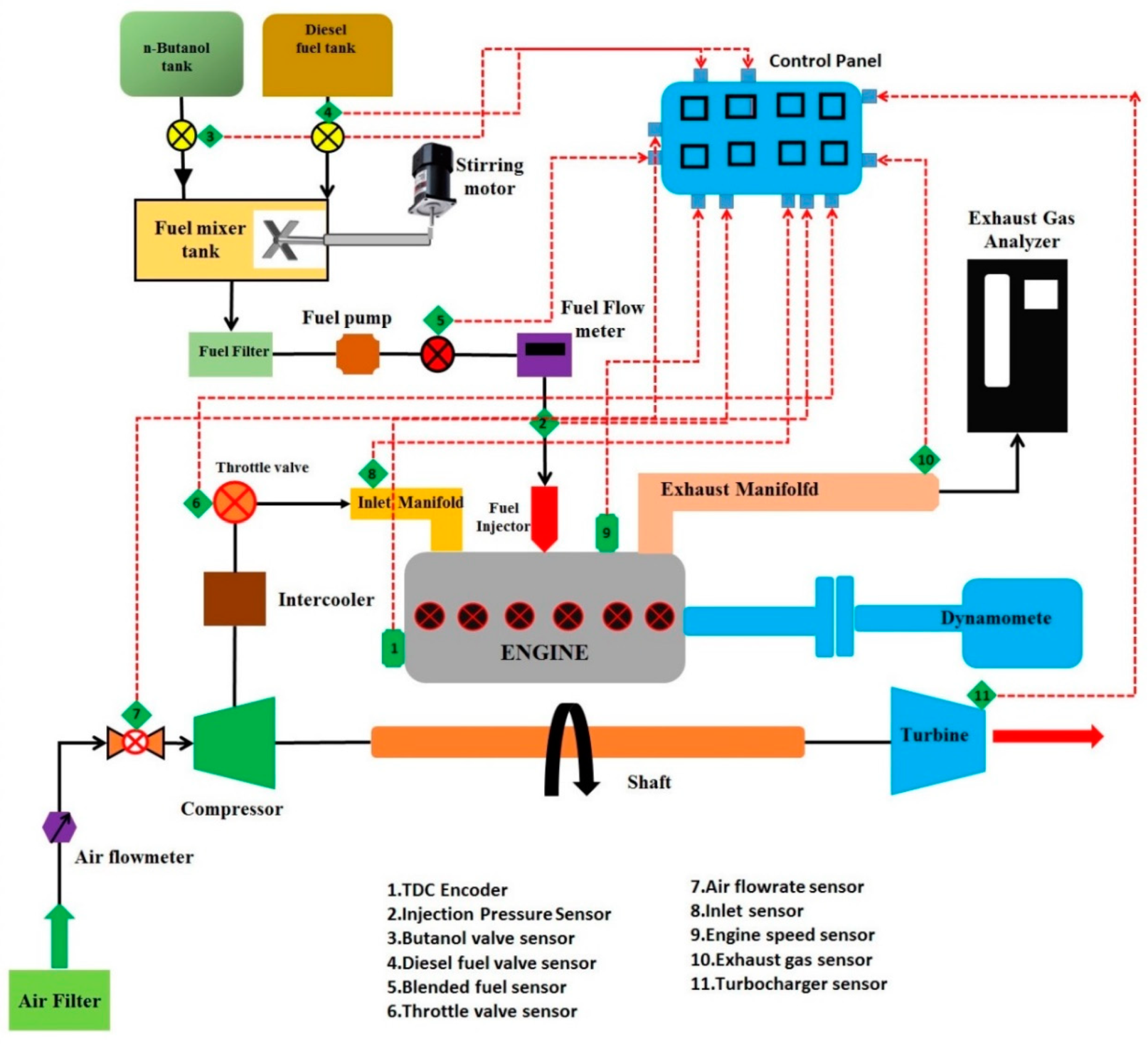

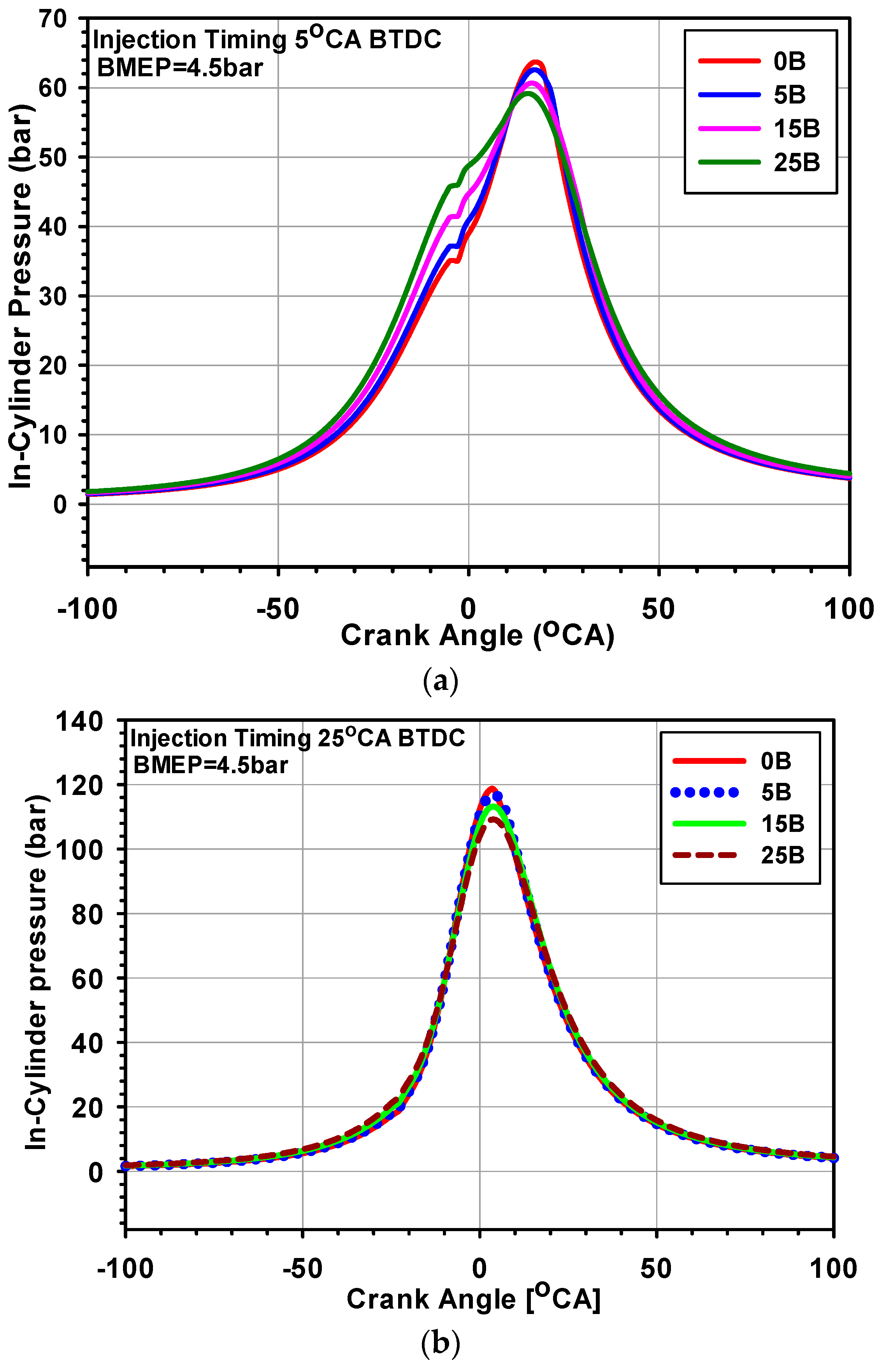
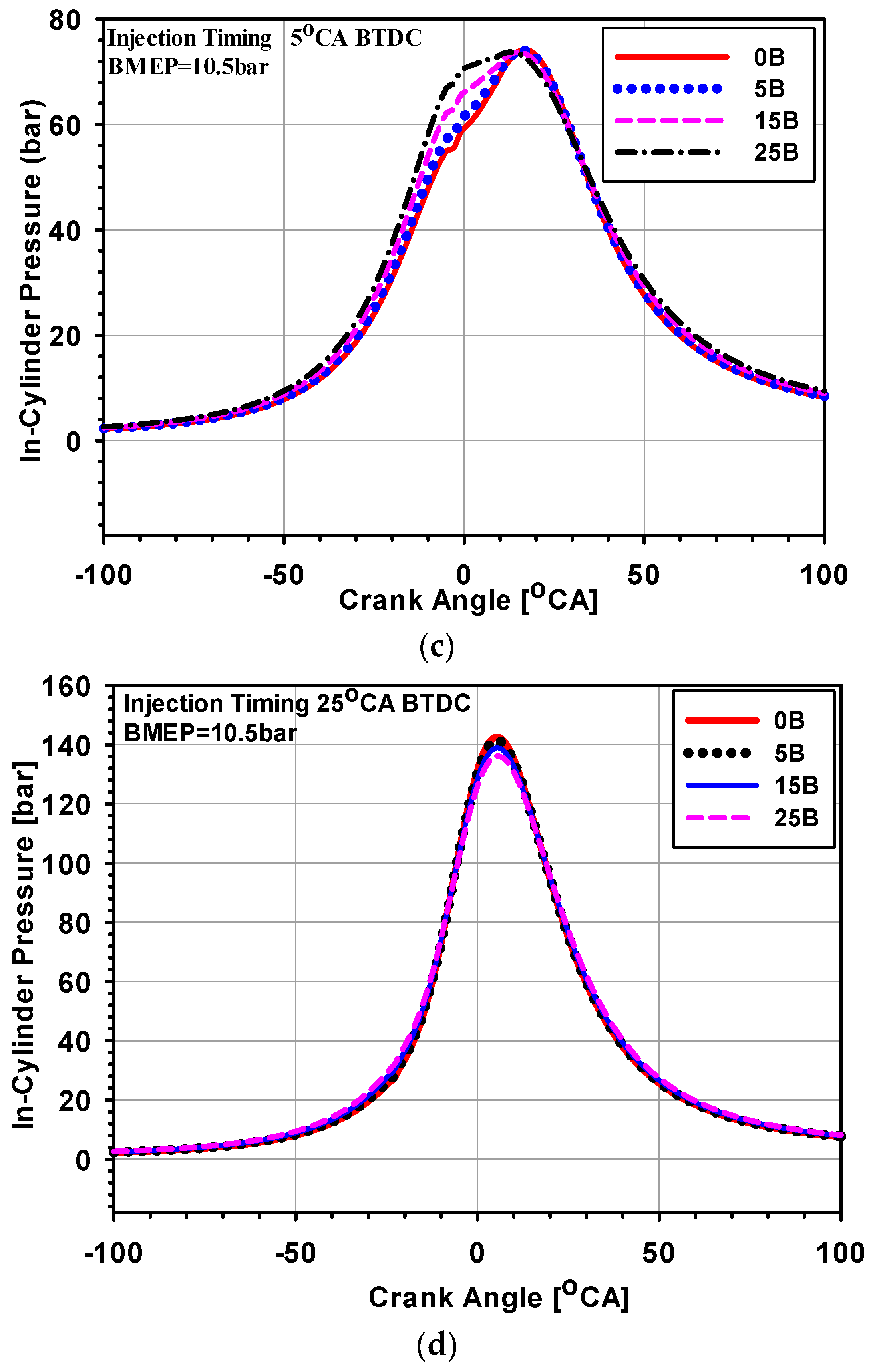
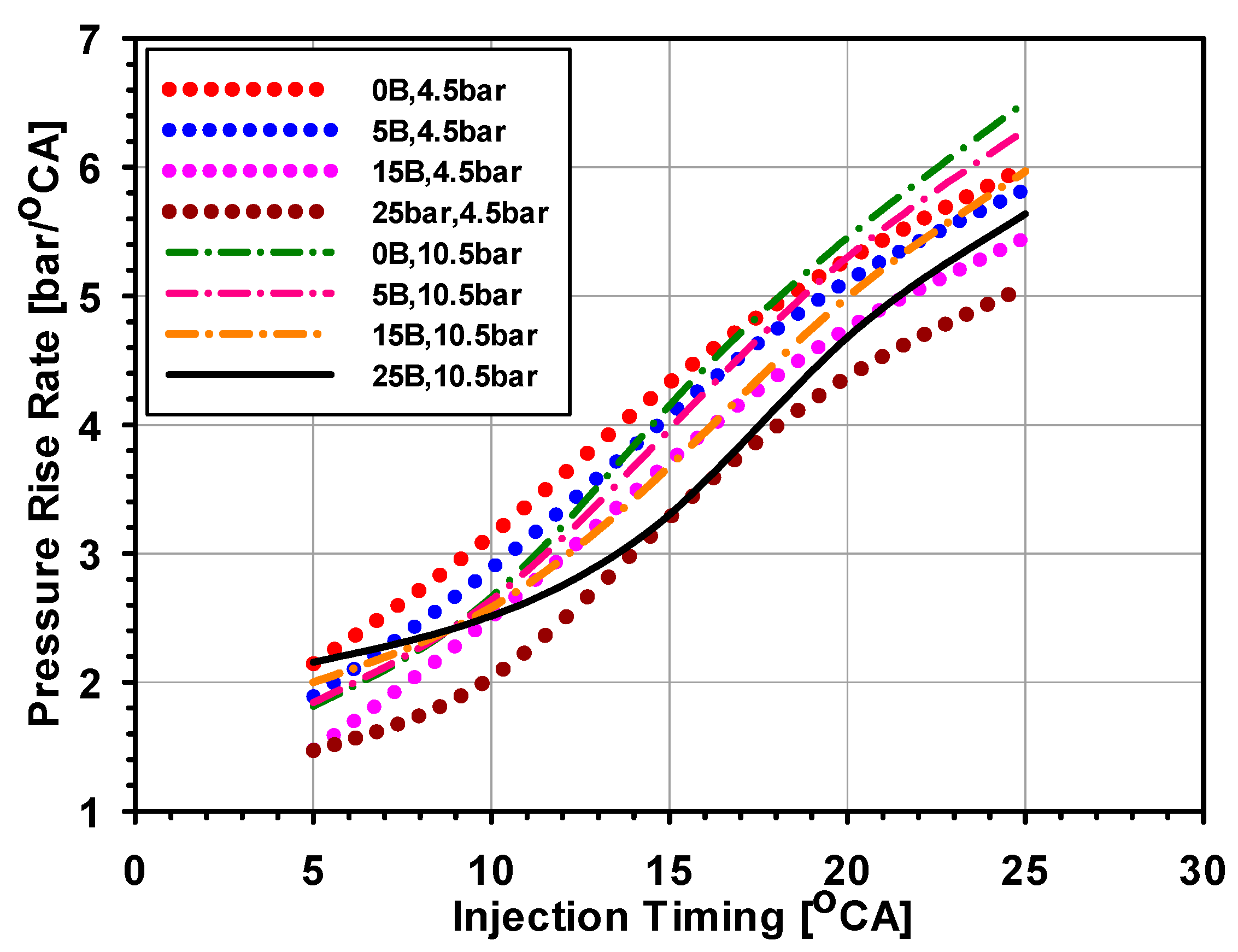
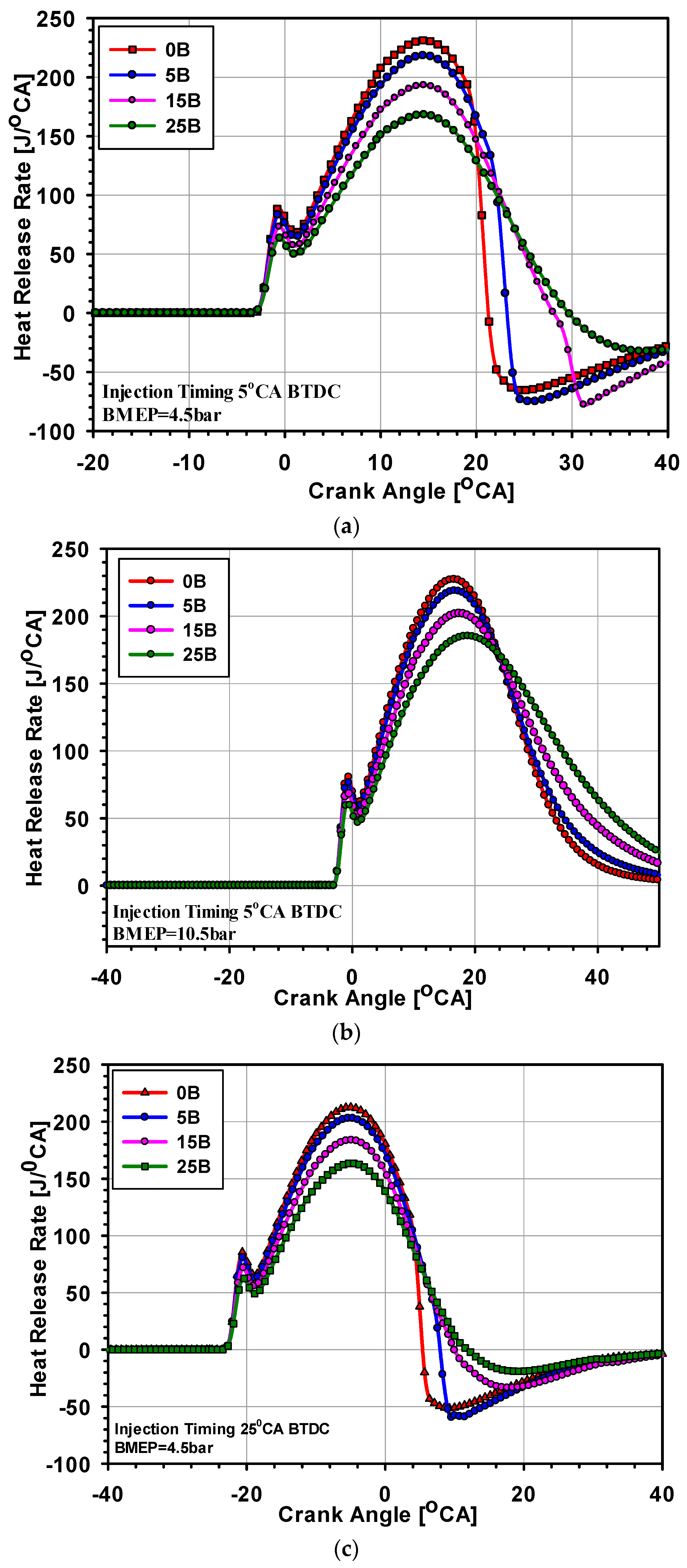
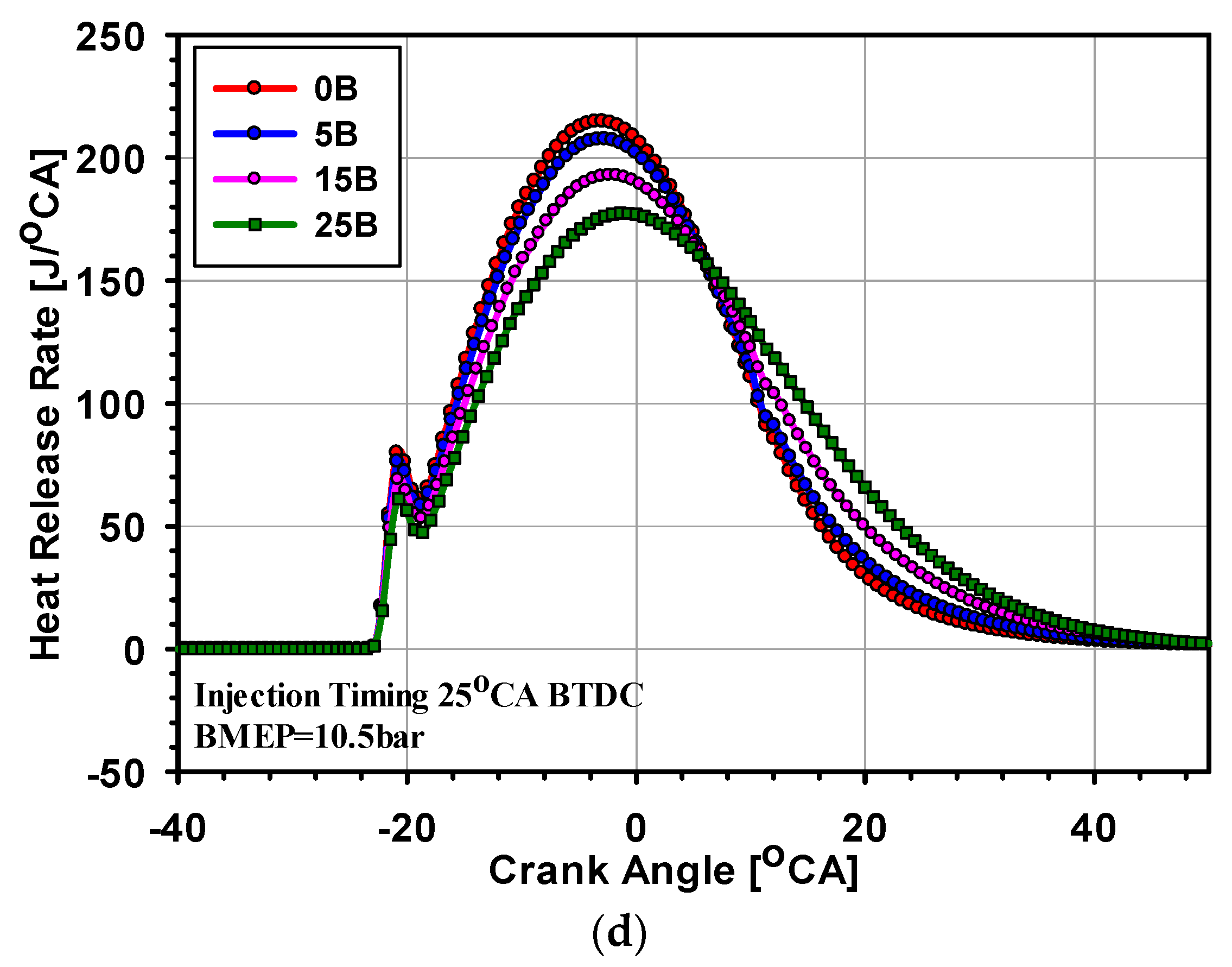
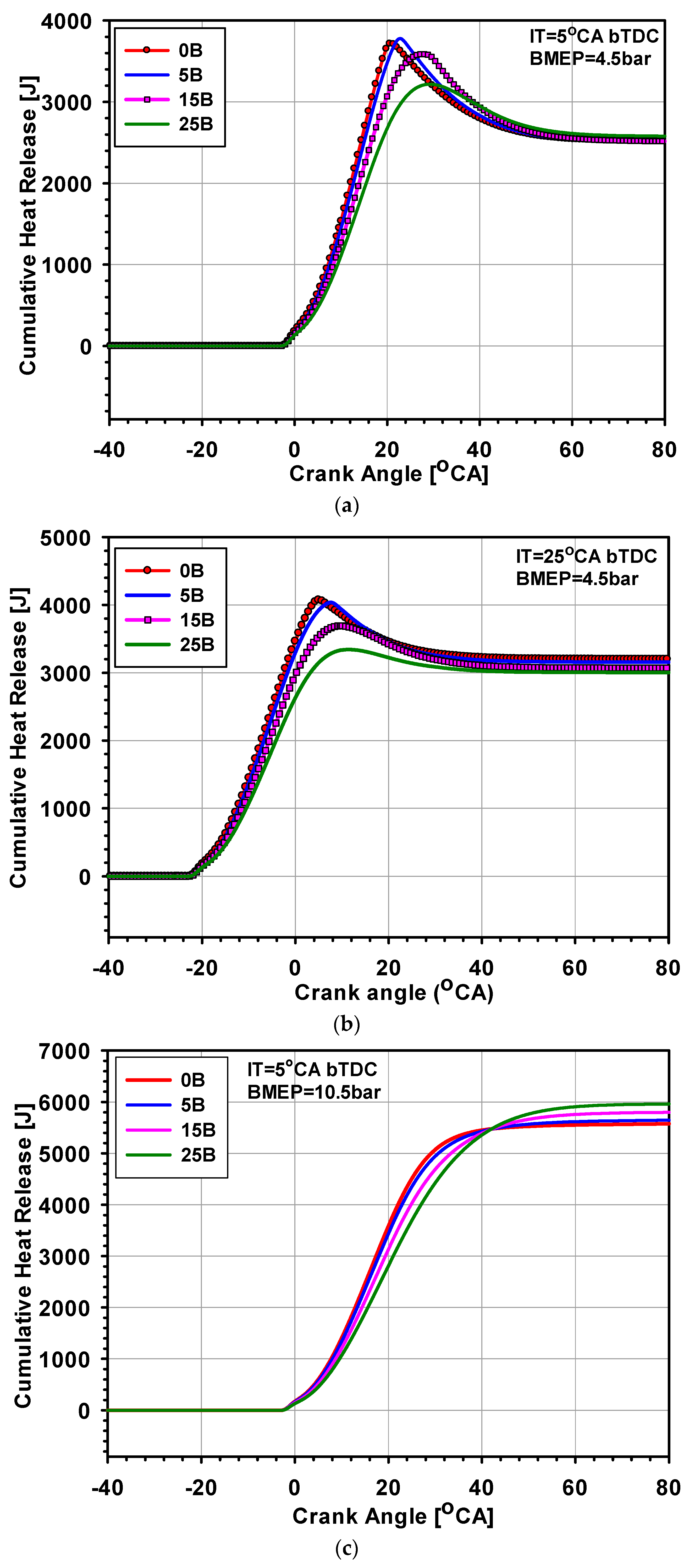



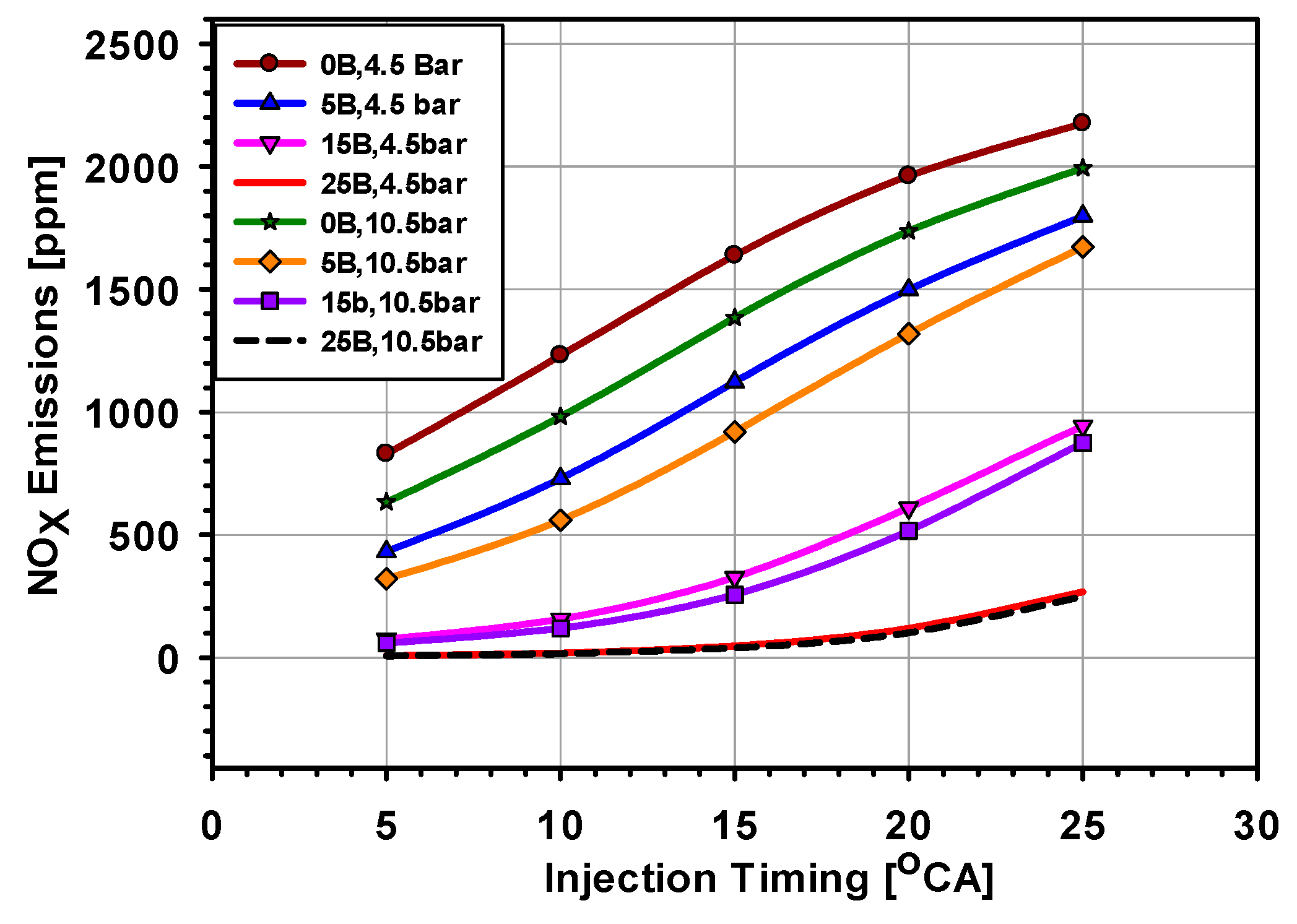

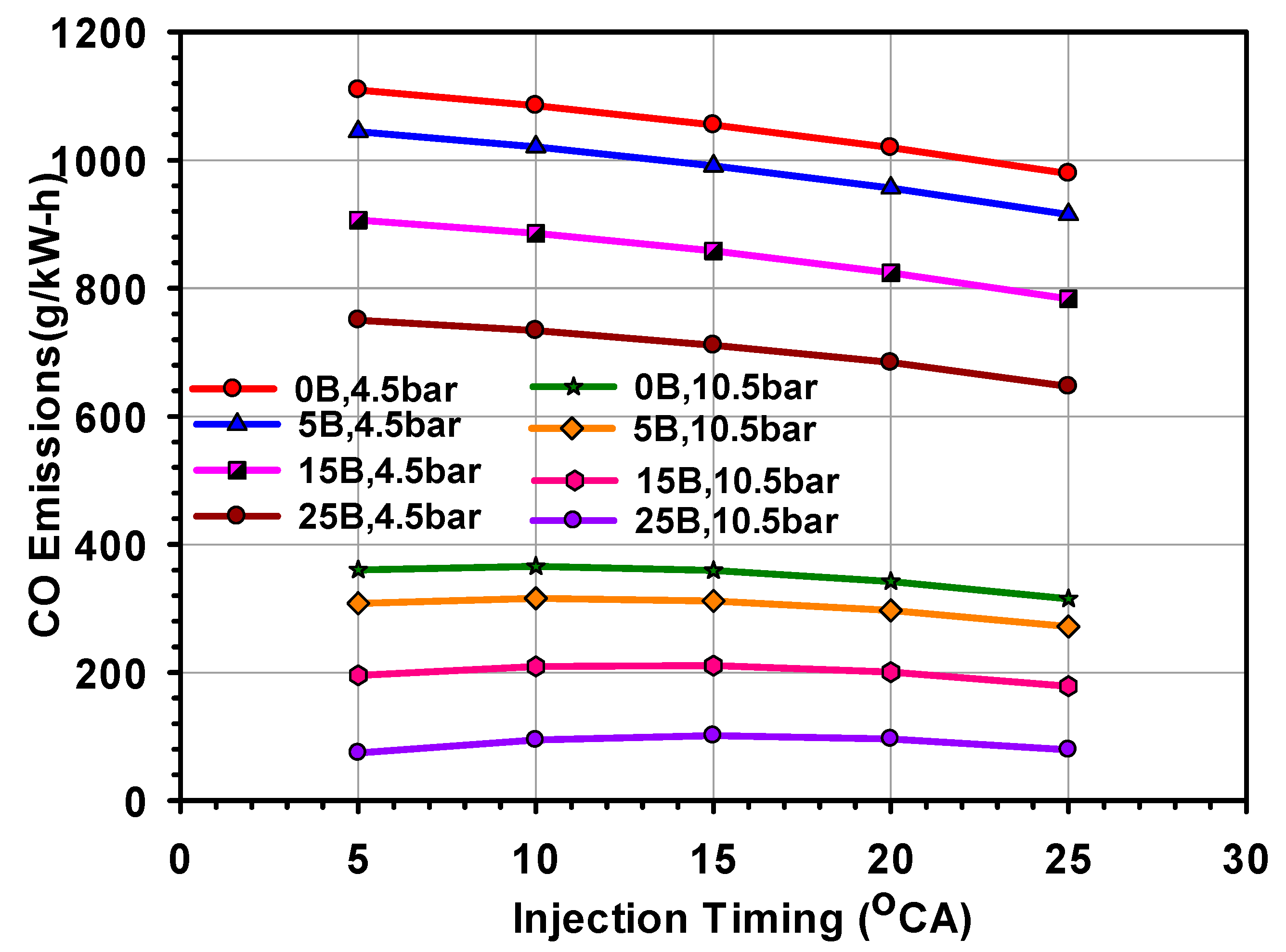
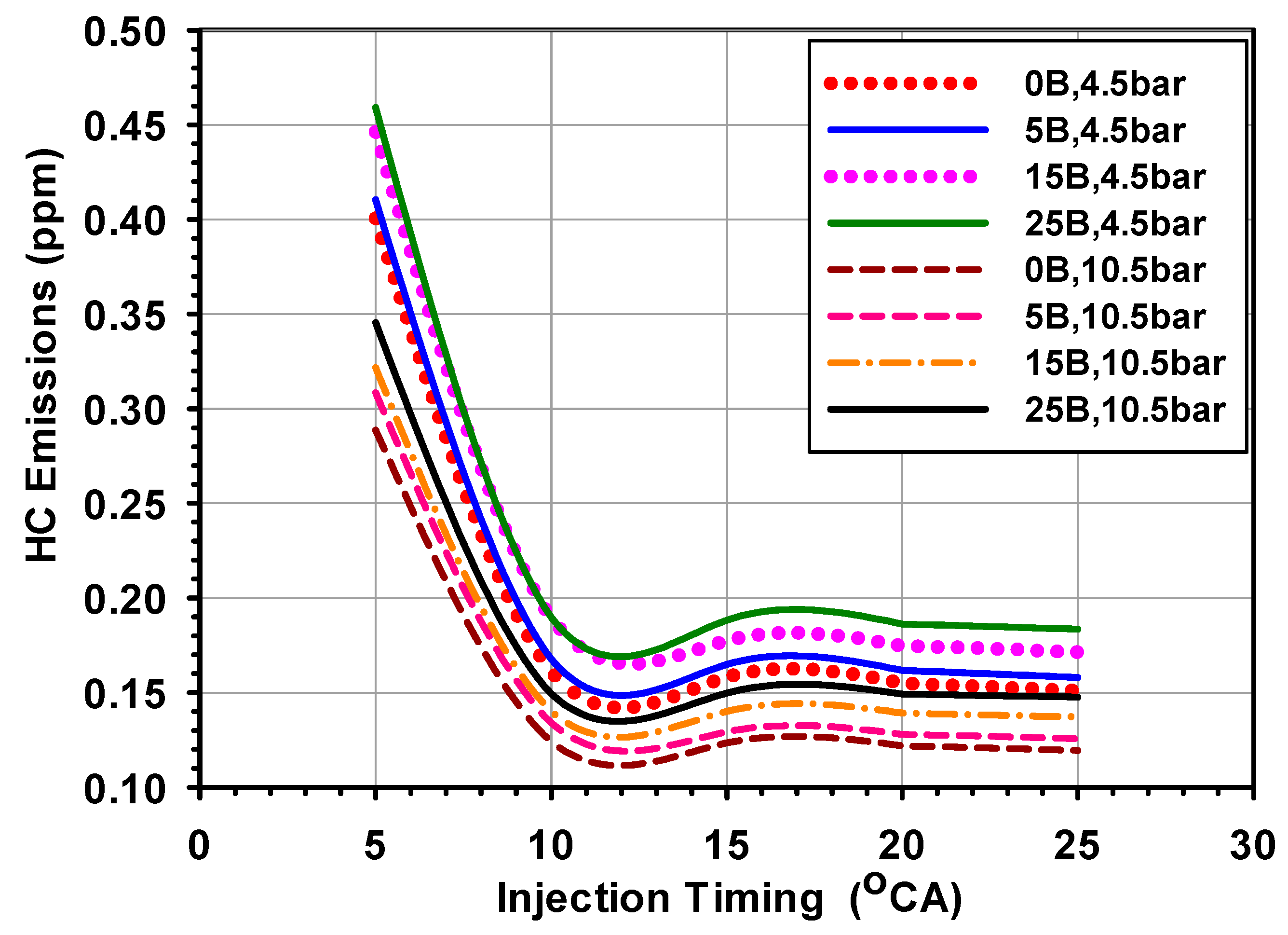
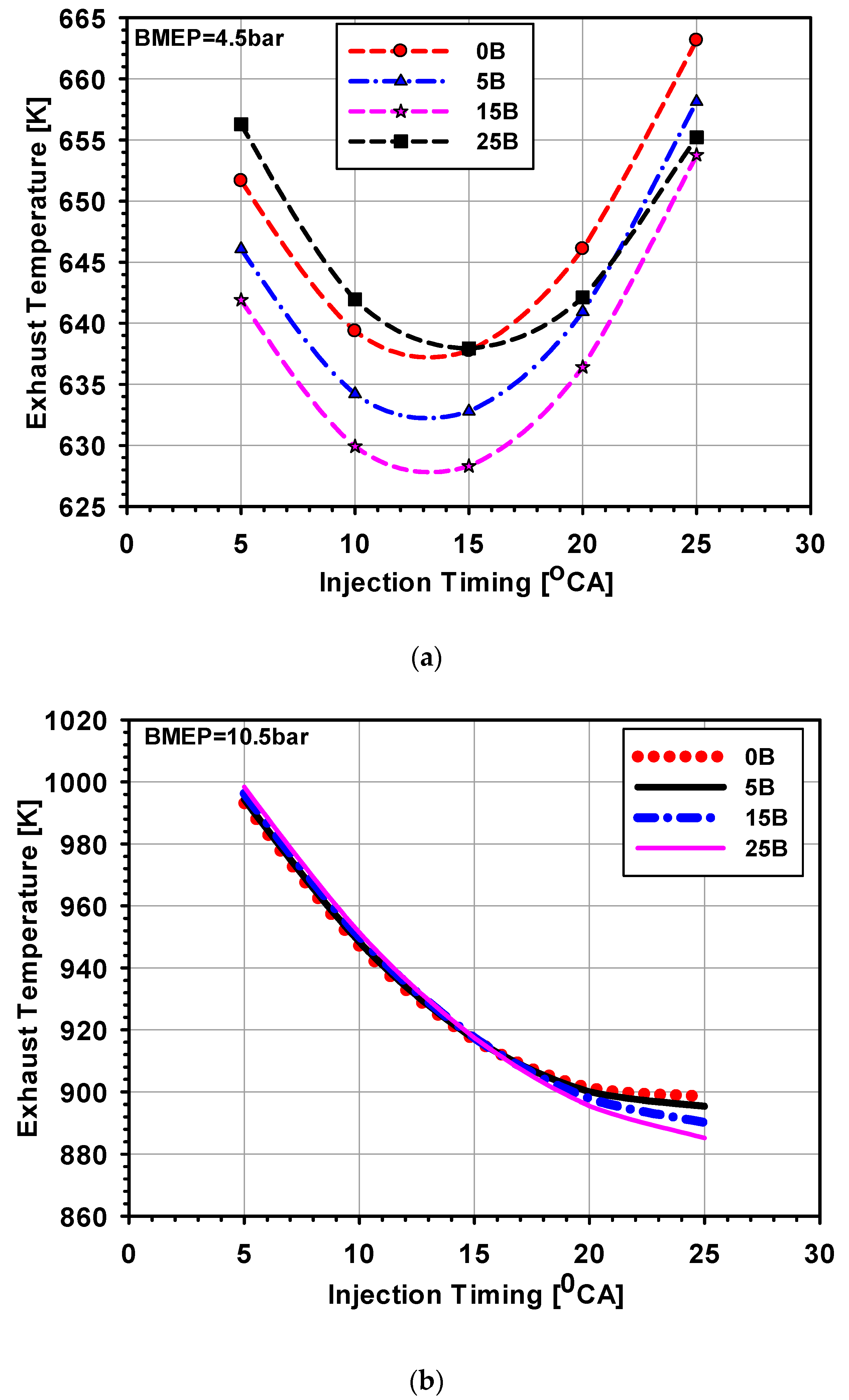
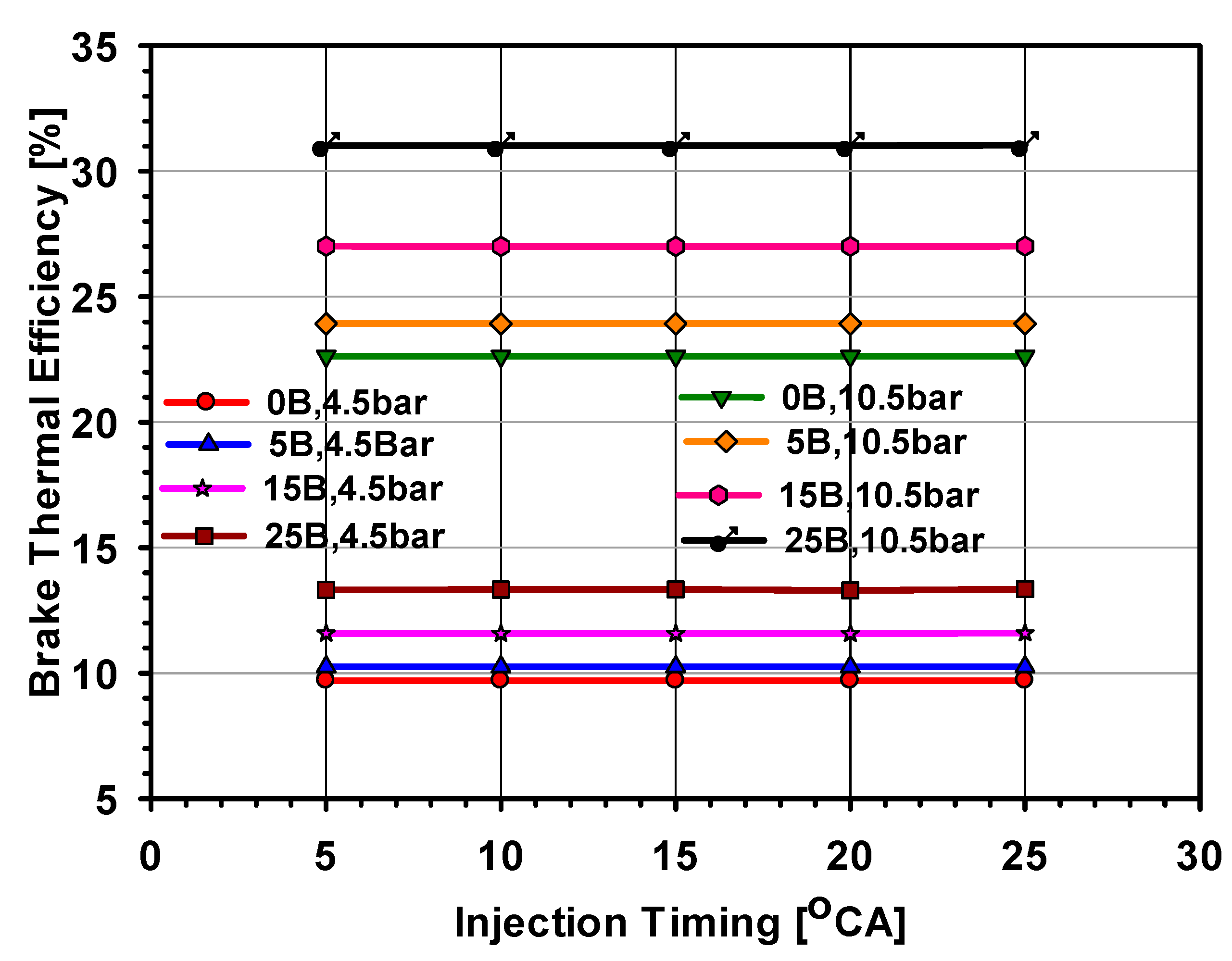
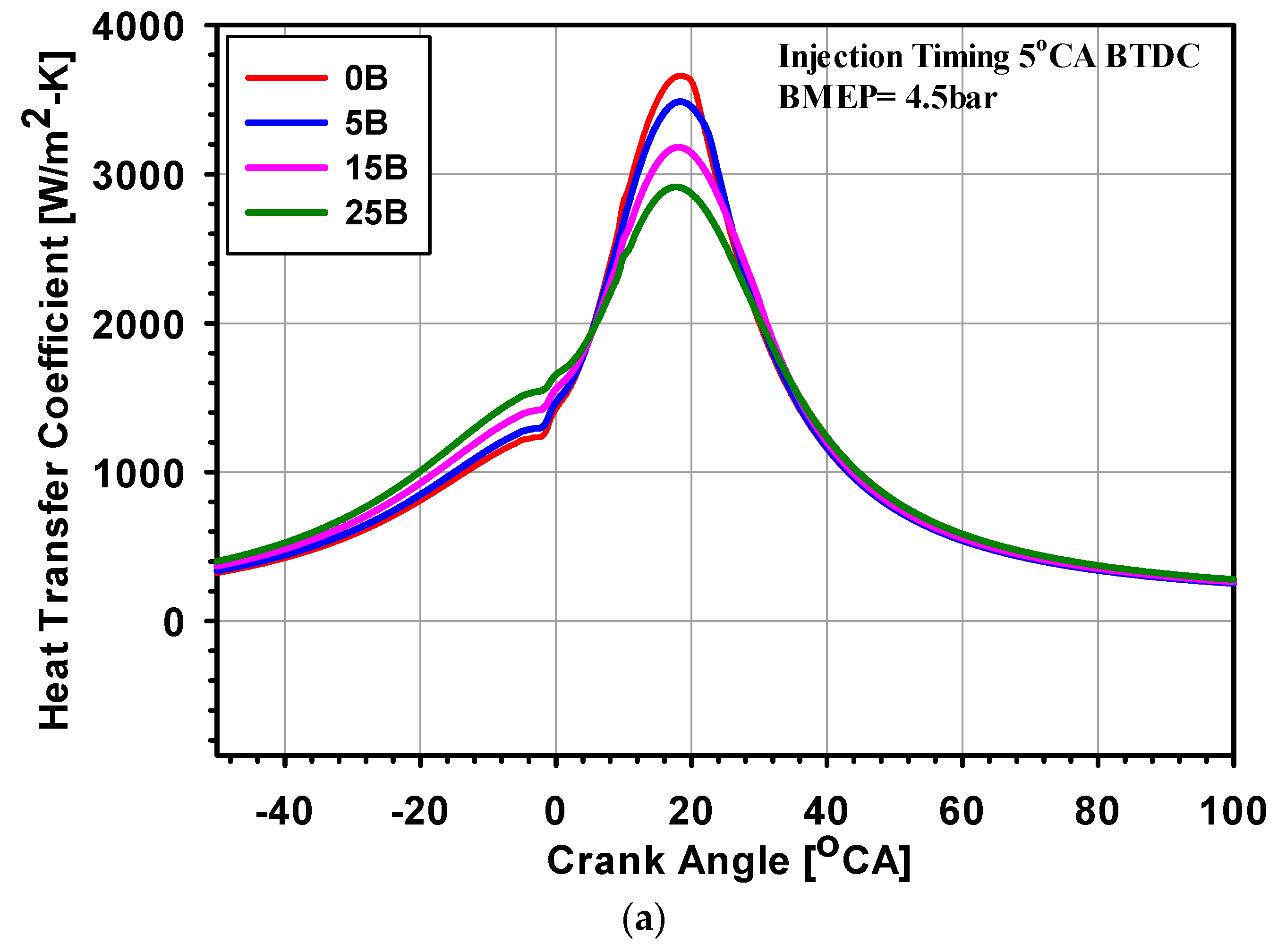

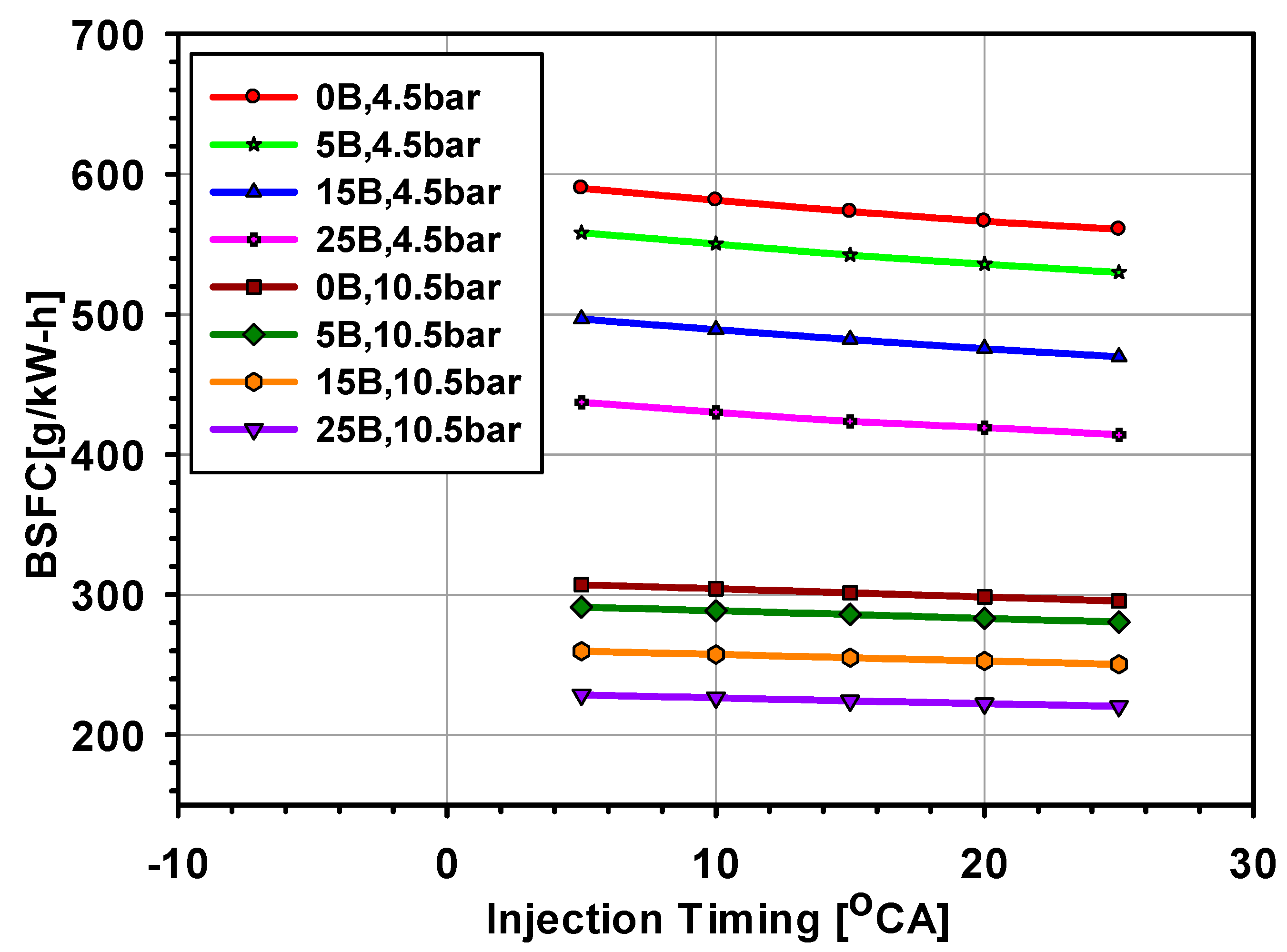
| Engine Parameters | Values |
|---|---|
| Engine Power | 298 (kW) |
| Bore | 119 (mm) |
| Stroke | 175 (mm) |
| Connecting Rod Length | 300 (mm) |
| Total Displacement | 11.7 (L) |
| Cylinder Configuration | 6 in-line |
| Compression Ratio | 16.5 |
| Turbocharger | 1 unit |
| Fuel injection nozzle | 8 holes |
| Injection pressure | 2000 (bar) |
| Property | n-Butanol | Iso-Butanol | Sec-Butanol | Ter-Butanol |
|---|---|---|---|---|
| Molecular weight (kg/kmol) | 74.12 | 74.12 | 74.12 | 74.12 |
| Density (kg/m3) at 15 °C | 809.7 | 802 | 806 | 789 |
| Self-ignition Temperature (°C) | 385 | 415.6 | 406.1 | 477.8 |
| Lower heating value (MJ/kg) | 33.09 | 33.11 | 32.74 | 29.79 |
| Latent heat of evaporation (kJ/kg) | 581.4 | 684 | 671 | 511 |
| Flash point (°C) | 37 | 28 | 24 | Miscible |
| Water solubility (g/100 mL) | 7.7 | 8 | 12.75 | 11 |
| Fuel Properties | Diesel | n-Butanol | 5B | 15B | 25B |
|---|---|---|---|---|---|
| Average Molecular Formula | C13.5H23.6 | C4H9OH | C7.2H12.73O0.065 | C7.1H12.81O0.196 | C6.81H12.89O0.328 |
| Molecular weight (kg/kmol) | 185.6 | 74.12 | 99.909 | 101.438 | 99.908 |
| Density @ 20C (kg/m3) | 840–880 | 813 | 843.46 | 840.36 | 837.23 |
| Lower calorific value (MJ/kg) | 42.5 | 33.1 | 42.05 | 41.14 | 40.22 |
| Heat of vaporization (MJ/kg) | 0.27 | 0.581 | 0.285 | 0.315 | 0.346 |
| Cetane number | 45–55 | 17 | 50.7 | 44.8 | 43.8 |
| Stoichiometric air fuel ratio | 14.43 | 11.19 | 14.27 | 14.13 | 13.64 |
| Carbon ratio (wt%) | 87.29 | 64.82 | 86.21 | 83.96 | 81.77 |
| Oxygen ratio (wt%) | 0 | 21.59 | 1.04 | 3.13 | 5.24 |
| Hydrogen ratio (wt%) | 12.7 | 13.5 | 12.75 | 12.82 | 12.90 |
| H/C ratio | 1.75 | 2.5 | 1.78 | 1.80 | 1.89 |
| Flash point (°C) | 85 | 37 | - | - | - |
| Kinematic viscosity at 40 °C (cST) | 3 | 2.27 | 2.65 | 2.53 | 2.47 |
| Self-Ignition Temperature (°C) | >250 | 385 | - | - | - |
| Injection Timing | Maximum in-Cylinder Pressure/Bar | Degrees of CA (CAD) | |||||||||
|---|---|---|---|---|---|---|---|---|---|---|---|
| BMEP/Bar | Fuel | 5 | 10 | 15 | 20 | 25 | 5 | 10 | 15 | 20 | 25 |
| 4.5 | 0B | 63.7 | 77.2 | 91.7 | 105.9 | 118.7 | 17.5 | 13.7 | 9.7 | 6.4 | 3.5 |
| 5B | 62.6 | 75.9 | 90.2 | 104.2 | 117.0 | 17.6 | 13.0 | 9.5 | 6.4 | 4.0 | |
| 15B | 60.7 | 73.6 | 87.4 | 100.8 | 113.2 | 16.8 | 13.0 | 9.4 | 6.0 | 3.9 | |
| 25B | 59.2 | 71.6 | 84.7 | 97.5 | 109.2 | 15.3 | 12.3 | 9.2 | 6.4 | 3.7 | |
| 10.5 | 0B | 74.2 | 89.8 | 106.9 | 124.7 | 142.5 | 16.6 | 13.3 | 10.0 | 7.7 | 5.7 |
| 5B | 74.0 | 89.4 | 106.3 | 123.8 | 141.4 | 16.6 | 12.7 | 10.0 | 7.3 | 5.3 | |
| 15B | 73.7 | 88.6 | 104.9 | 121.8 | 138.9 | 15.4 | 12.0 | 9.6 | 7.7 | 5.7 | |
| 25B | 73.7 | 87.9 | 103.3 | 119.6 | 136.1 | 13.3 | 11.4 | 9.4 | 7.4 | 5.5 | |
| Injection Timing | Maximum Heat Release Rate/J/°CA | Degrees of Occurrence CA (CAD) | |||||||||
|---|---|---|---|---|---|---|---|---|---|---|---|
| BMEP/Bar | Fuel | 5 | 10 | 15 | 20 | 25 | 5 | 10 | 15 | 20 | 25 |
| 4.5 | 0B | 231.3 | 229.0 | 224.6 | 218.8 | 212.7 | 14.4 | 9.6 | 4.9 | −0.1 | −5.0 |
| 5B | 218.2 | 216.4 | 212.8 | 208.2 | 203.0 | 14.4 | 9.4 | 4.5 | −0.1 | −5.4 | |
| 15B | 193.2 | 192.3 | 190.0 | 187.1 | 183.8 | 14.5 | 9.7 | 5.0 | 0.1 | −4.9 | |
| 25B | 168.2 | 167.9 | 166.9 | 165.3 | 163.6 | 14.5 | 9.4 | 4.6 | −0.3 | −4.5 | |
| 10.5 | 0B | 227.3 | 225.4 | 222.8 | 219.0 | 214.8 | 16.6 | 11.3 | 6.5 | 1.7 | −2.9 |
| 5B | 218.9 | 217.2 | 214.7 | 211.3 | 207.6 | 16.6 | 12.0 | 6.6 | 1.9 | −2.8 | |
| 15B | 202.0 | 200.1 | 198.1 | 195.5 | 192.9 | 17.4 | 12.7 | 7.7 | 3.0 | −2.4 | |
| 25B | 185.3 | 183.2 | 181.3 | 179.4 | 177.4 | 18.8 | 13.4 | 8.7 | 4.0 | −1.4 | |
| Fuels | Lower Calorific Value (MJ/kg) | Heat of Vaporization (MJ/kg) |
|---|---|---|
| Diesel | 42.5 | 0.27 |
| n-Butanol | 33.1 | 0.581 |
| 5B | 42.05 | 0.285 |
| 15B | 41.14 | 0.315 |
| 25B | 40.22 | 0.346 |
© 2019 by the authors. Licensee MDPI, Basel, Switzerland. This article is an open access article distributed under the terms and conditions of the Creative Commons Attribution (CC BY) license (http://creativecommons.org/licenses/by/4.0/).
Share and Cite
Ahmed, S.A.; Zhou, S.; Zhu, Y.; Feng, Y.; Malik, A.; Ahmad, N. Influence of Injection Timing on Performance and Exhaust Emission of CI Engine Fuelled with Butanol-Diesel Using a 1D GT-Power Model. Processes 2019, 7, 299. https://doi.org/10.3390/pr7050299
Ahmed SA, Zhou S, Zhu Y, Feng Y, Malik A, Ahmad N. Influence of Injection Timing on Performance and Exhaust Emission of CI Engine Fuelled with Butanol-Diesel Using a 1D GT-Power Model. Processes. 2019; 7(5):299. https://doi.org/10.3390/pr7050299
Chicago/Turabian StyleAhmed, Salman Abdu, Song Zhou, Yuanqing Zhu, Yongming Feng, Adil Malik, and Naseem Ahmad. 2019. "Influence of Injection Timing on Performance and Exhaust Emission of CI Engine Fuelled with Butanol-Diesel Using a 1D GT-Power Model" Processes 7, no. 5: 299. https://doi.org/10.3390/pr7050299
APA StyleAhmed, S. A., Zhou, S., Zhu, Y., Feng, Y., Malik, A., & Ahmad, N. (2019). Influence of Injection Timing on Performance and Exhaust Emission of CI Engine Fuelled with Butanol-Diesel Using a 1D GT-Power Model. Processes, 7(5), 299. https://doi.org/10.3390/pr7050299






